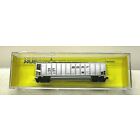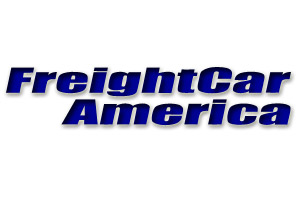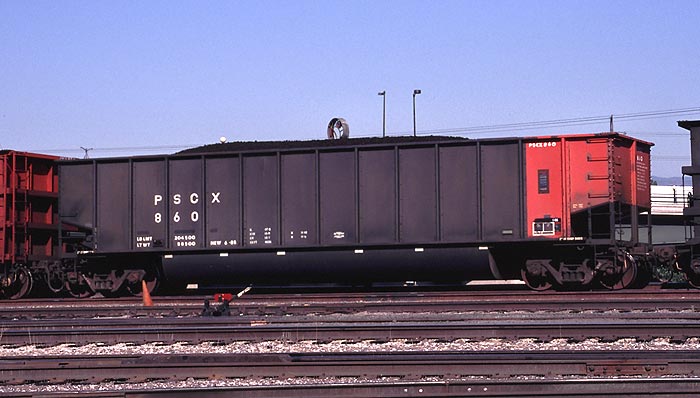Model Information: These models come with optional, user-installed weights and internal bracing.
Prototype History: The Powder River Basin is a hot bed of coal activity. There is more coal run out of this one area than all other areas of the US combined. It is an amazing railfan opportunity, as there is train after train after train of 100+ cars leaving the basin for power plants all over the country. The trains pull through a mine and are flow loaded, with the train continuously moving at very slow speed, while the loader operator drops up to 110 tons of coal into each aluminum car. It is an awesome site to see. The flow loader piles the coal into the car, and each load settles to it's own shape. At the other end of the chain, many of the power plants or shipping docks (yes, some of this high quality cleaner burning coal goes overseas, too) unload the cars by rolling them over, while they are still coupled in the train. This is accomplished by use of a rotary coupler, which needs to be oriented correctly in the train in order to work. The orientation is accomplished visually by the unique colored end, or rotary end on the car. You will find these trains anywhere along their route with all of the rotaries lined up in the same direction. Each car is equipped with one rotary coupler, and one fixed coupler (the exceptions are the double rotary cars, which we'll get to in a second), so that the car can be rolled over without uncoupling. The most recent version of the car is constructed of aluminum for weight and strength reasons. The side stakes are a box shape of aluminum, and have distinctive crisp square corners. The earlier version of the car was made in steel, with folded steel "hat section" stiles that were thinner and rounder. Johnstown America is a pioneer in getting the most out of their materials.
When they introduced the revolutionary original all steel construction Bethgon, they started a change in the way railroads thought about coal transportation. With the Coalporter, the revolution continued. Now they are working on even more advanced systems to deliver clean fuel to America's electric plants. With their innovations, the Twin Tub has become one of the dominant coal conveyances in modern railroading. Certainly it is distinctive seeing 105 car unit trains on the rails. The cars on the road today are divided into several types. The railroad trains, like BNSF, and Norfolk Southern, are contract trains. They transport on routes that they have bid for and service with a rotating pool of equipment. The power company trains are owned or leased specifically by a particular power company, and run on a dedicated route from the coal mine to the power plant and back. From time to time, the power plant will require more coal than their owned equipment is capable of carrying, and they will lease or hire additional cars. These may come from a leasing organization (Transisco, Systems Fuels, or First Union), a railroad, or another power plant that may have over capacity. Portland General Electric is a good example of leasable trains. The Portland Rose cars often sit idle when local hydro electric power plants are generating at full capacity. At these times, the cars get leased out to other power companies at favorable rates. It is not unusual to see a train full of Portland Rose cars on it's way to San Antonio or St Louis when the Pacific Northwest has full rivers! The double rotary cars ride next to the locomotives or at any position where the train may need to be pulled in both directions to unload. If the unloader is placed on a stub track, at the end of the line, or on a wye, the loco may be tied onto either end, making it impossible to predict which way to order the cars (rotary first or non-rotary first). In these instances a double rotary is used. They are very distinctive, as whatever color is used to indicate a rotary coupler is visible on both ends. In the case of the PGEX cars, each end is equipped with colored panels and the four color rose.
When they introduced the revolutionary original all steel construction Bethgon, they started a change in the way railroads thought about coal transportation. With the Coalporter, the revolution continued. Now they are working on even more advanced systems to deliver clean fuel to America's electric plants. With their innovations, the Twin Tub has become one of the dominant coal conveyances in modern railroading. Certainly it is distinctive seeing 105 car unit trains on the rails. The cars on the road today are divided into several types. The railroad trains, like BNSF, and Norfolk Southern, are contract trains. They transport on routes that they have bid for and service with a rotating pool of equipment. The power company trains are owned or leased specifically by a particular power company, and run on a dedicated route from the coal mine to the power plant and back. From time to time, the power plant will require more coal than their owned equipment is capable of carrying, and they will lease or hire additional cars. These may come from a leasing organization (Transisco, Systems Fuels, or First Union), a railroad, or another power plant that may have over capacity. Portland General Electric is a good example of leasable trains. The Portland Rose cars often sit idle when local hydro electric power plants are generating at full capacity. At these times, the cars get leased out to other power companies at favorable rates. It is not unusual to see a train full of Portland Rose cars on it's way to San Antonio or St Louis when the Pacific Northwest has full rivers! The double rotary cars ride next to the locomotives or at any position where the train may need to be pulled in both directions to unload. If the unloader is placed on a stub track, at the end of the line, or on a wye, the loco may be tied onto either end, making it impossible to predict which way to order the cars (rotary first or non-rotary first). In these instances a double rotary is used. They are very distinctive, as whatever color is used to indicate a rotary coupler is visible on both ends. In the case of the PGEX cars, each end is equipped with colored panels and the four color rose.
Road Name History: The BNSF Railway (reporting mark BNSF) is one of the largest freight railroad networks in North America, second to the Union Pacific Railroad (UP) (its primary competitor for Western U.S. freight), and is one of seven North American Class I railroads. It has 48,000 employees, 32,500 miles (52,300 km) of track in 28 states, and over 8,000 locomotives. It has three transcontinental routes that provide high-speed links between the western and eastern United States. BNSF trains traveled over 169 million miles in 2010, more than any other North American railroad.[2] The BNSF and UP have a duopoly on all transcontinental freight rail lines in the Western U.S. and share trackage rights over thousands of miles of track.
According to corporate press releases, the BNSF Railway is among the top transporters of intermodal freight in North America. It also hauls bulk cargo. For instance, the railroad hauls enough coal to generate roughly ten percent of the electricity produced in the United States.
Headquartered in Fort Worth, Texas, the railroad is a wholly owned subsidiary of Berkshire Hathaway Inc.
The creation of BNSF started with the formation of a holding company, the Burlington Northern Santa Fe Corporation on September 22, 1995. This new holding company then purchased the Atchison, Topeka and Santa Fe Railway (often called the "Santa Fe") and Burlington Northern Railroad, and formally merged the railways into the Burlington Northern and Santa Fe Railway on December 31, 1996. On January 24, 2005, the railroad's name was officially changed to "BNSF Railway," using the initials of its original name.
In 1999, Burlington Northern Santa Fe and the Canadian National Railway announced their intention to merge and form a new corporation entitled North American Railways to be headquartered in Montreal, Canada. The United States' Surface Transportation Board (STB) placed a 15-month moratorium on all rail mergers, which ended this merger.
On November 3, 2009, Warren Buffett's Berkshire Hathaway announced it would acquire the remaining 77.4 percent of BNSF it did not already own for $100 per share in cash and stock - a deal valued at $44 billion. The company is investing an estimated $34 billion in BNSF and acquiring $10 billion in debt. On February 12, 2010, shareholders of Burlington Northern Santa Fe Corporation voted in favor of the acquisition.
According to corporate press releases, the BNSF Railway is among the top transporters of intermodal freight in North America. It also hauls bulk cargo. For instance, the railroad hauls enough coal to generate roughly ten percent of the electricity produced in the United States.
Headquartered in Fort Worth, Texas, the railroad is a wholly owned subsidiary of Berkshire Hathaway Inc.
The creation of BNSF started with the formation of a holding company, the Burlington Northern Santa Fe Corporation on September 22, 1995. This new holding company then purchased the Atchison, Topeka and Santa Fe Railway (often called the "Santa Fe") and Burlington Northern Railroad, and formally merged the railways into the Burlington Northern and Santa Fe Railway on December 31, 1996. On January 24, 2005, the railroad's name was officially changed to "BNSF Railway," using the initials of its original name.
In 1999, Burlington Northern Santa Fe and the Canadian National Railway announced their intention to merge and form a new corporation entitled North American Railways to be headquartered in Montreal, Canada. The United States' Surface Transportation Board (STB) placed a 15-month moratorium on all rail mergers, which ended this merger.
On November 3, 2009, Warren Buffett's Berkshire Hathaway announced it would acquire the remaining 77.4 percent of BNSF it did not already own for $100 per share in cash and stock - a deal valued at $44 billion. The company is investing an estimated $34 billion in BNSF and acquiring $10 billion in debt. On February 12, 2010, shareholders of Burlington Northern Santa Fe Corporation voted in favor of the acquisition.
Brand/Importer Information:  Hubert's Model Railroad Mfg Corp group was located in Roseburg, Oregon and then Cincinnati, Ohio. Frank Hubert purchased the toolings of the LBF company (a.k.a. USA Plastics), that itself succeeded to E&C Shops, both founded by Fred Becker. Hubert had been one of Becker's partners in LBF/USA Plastics. Later, when Hubert's operation folded by the end of 2007, the toolings were acquired by InterMountain.
Hubert's Model Railroad Mfg Corp group was located in Roseburg, Oregon and then Cincinnati, Ohio. Frank Hubert purchased the toolings of the LBF company (a.k.a. USA Plastics), that itself succeeded to E&C Shops, both founded by Fred Becker. Hubert had been one of Becker's partners in LBF/USA Plastics. Later, when Hubert's operation folded by the end of 2007, the toolings were acquired by InterMountain.
Like its predecessors, Hubert's released every road name with 12 to 48 different road numbers, offering the cars in 6- or 12-packs.

Like its predecessors, Hubert's released every road name with 12 to 48 different road numbers, offering the cars in 6- or 12-packs.
Item created by: mbierbauer on 2020-02-14 11:09:09
If you see errors or missing data in this entry, please feel free to log in and edit it. Anyone with a Gmail account can log in instantly.
If you see errors or missing data in this entry, please feel free to log in and edit it. Anyone with a Gmail account can log in instantly.










